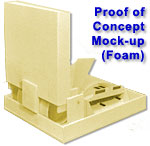It is the job of a product designer to create the ideas
for his or her client. Designers must be able to 'sell' their ideas to
their clients. This will involve spending a great deal of time drawing
and modeling. Initially this may involve just conceptual drawing and modeling,
but once the idea has been 'sold', much more detailed work needs to be
done on investigating suitable materials and methods of manufacture. Finally
the whole project is presented to the client for assessment. Product design
is never easy. Not only must a solution solve the original brief, it must
do so economically and safely. The materials chosen need to be suitable
and the method of manufacture needs to be appropriate to both the form
and function of the proposed product.
And all of this needs to be displayed to the client.
Models and Prototypes are helpful in this aspect, in that many people
are visual learners, and can really understand a picture or 3D model.
Directions: You have two choices:
-
Draw detailed sketches of your redesigned
product, including measurements, and scale. With these drawings you
must create a Production Analysis Report that includes descriptions
of the manufacturing process, cost analysis, restraints of use, the
original product design, other alternative material choices and pieces
of the materials to be used.
-
Create a 3D model. The model does
not have to be the same size as the actual product, but it must be
to scale with an available legend. Along with the model, your team
needs to create a Production Analysis Report that outlines the manufacturing
process, cost analysis, restraints of use, the original product design,
other alternative material choices and pieces of the materials to
be used.
Check out the Rubrics for the project before
you start
 
|
Why make Prototypes
Prototypes are used for a variety of purposes,
including:
-
presentation and demonstration of inventions.
-
prove out the design or size of the invention.
-
understand feasibility of certain aspects of
the design.
-
to discover different and valuable ideas about
the design.
-
use models and pictures
to develop and communicate the design.
-Labeled sketches are used to show the details of the designs.
-Illustrate alternatives using sketches and models and make
choices between them, showing an awareness of constraints.
-Make preliminary models to explore and test the design thinking
and use formal drawing methods to communicate their intentions.
 |


|
|

